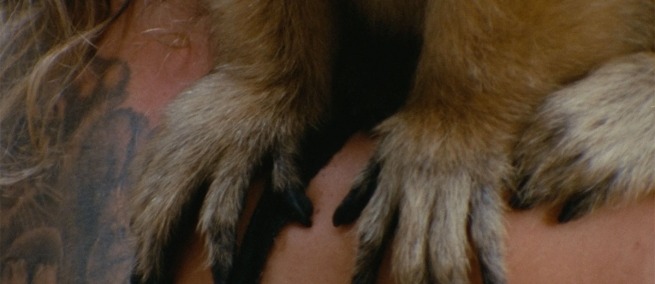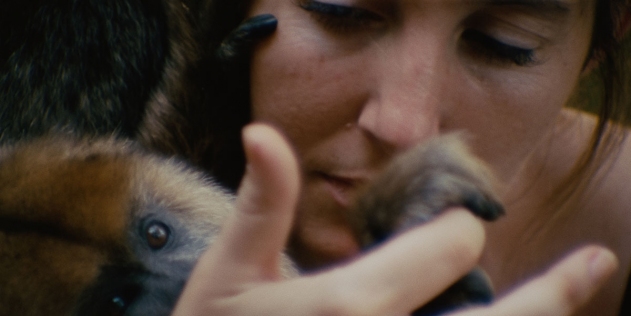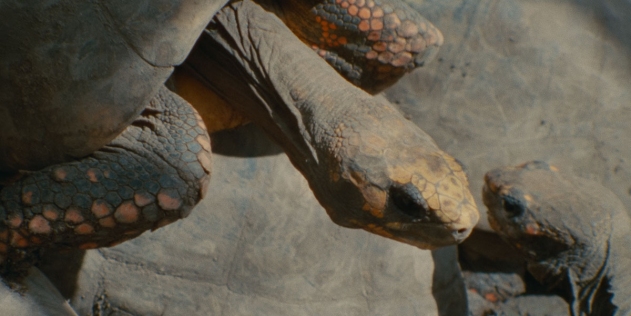
Jessica Sarah Rinland’s COLLECTIVE MONOLOGUE (MONÓLOGO COLECTIVO) embeds within the lives of carers and animals navigating various forms of enclosure at two government-owned zoos in Argentina – La Plata and Buenos Aires. Through a mix of 16mm, CCTV, and archival footage, we get to know not only the animals who live in the zoos, but Maca, a caretaker who has transformed the institution’s practice of working with captive wildlife. COLLECTIVE MONOLOGUE made its world premiere at Locarno, and its North American premiere in the Wavelengths section at TIFF, where we sat down with Jessica Sarah Rinland. Meanwhile, the film has continued to play at festivals, including the BFI London Film Festival. Rinland has a new exhibition—focused on the work of wildlife photographer George Shiras—that just opened at Tabakalera, International Centre of Contemporary Culture, in San Sebastian, Spain. Extramission: The Capture of Glowing Eyes will be on view through January 2025.
Science & Film: Your films are often set in institutions with complicated histories and ethics, and zoos are not an exception. What drew you to them, and to the specific ones in which you filmed?
Jessica Sarah Rinland: The Buenos Aires Zoo was a space that I used to go to as a kid, and I remembered that the architecture was replicas of places where the animals come from. The first director of the zoo was German, from the Berlin Zoo where the enclosures for the animals are replicas of architecture from the countries where the animals come from. In a way, it's like these layers of copying and of replicas, which comes from my previous film. My point of interest was the Buenos Aires Zoo and the architecture, the replicas, the Hindu temple where the African elephants live now. So that was my point of entry.
The Buenos Aire Zoo closed in 2016 because of animal rights activists, [a group that] included the carers at the zoo as well. [When it reopened] in 2019 I started going there regularly. It had opened, but only a section of it opened, and then the name changed from a zoo to an eco-park. I rented an apartment that looked over the zoo. In the film, the panoramas that aren't surveillance are me filming from the balcony. I would spend my time going and meeting people that worked at the zoo.
I met Majo, who is a historian, very early on. It was the first time that I had been rejected from filming in an institution. As you know, I filmed at the British Museum and film at natural museums all the time. I got rejected four times from filming in the Buenos Aires Zoo. During that time where I was getting rejected, I met Maca, who's the carer. Before she worked at Buenos Aires, she worked at La Plata, which is a zoo that's an hour south of Buenos Aires, which is also now called a Bio Park. At the time, she was working seven days at Buenos Aires and seven days at La Plata—eventually she left Buenos Aires and now is working full time in La Plata.
La Plata is where my mum comes from, that her town, her city. I remember as a kid, they'd build these massive structures and then burn them at New Years. New Years of 2018 or 19 I met an anthropologist at the University of La Plata, who had been studying the history of these fireworks and this festivity. We drove around the whole of December going to meet different kids and groups that would build these structures. I spent three years going and filming and being there.

Courtesy of TIFF
S&F: What was your crew like?
JR: There were four of us in the crew. It was my friend Flor doing the camera assisting, Guido doing sound, my other friend Flor doing general assisting, and then Cami was the production manager and her brother worked at the zoo. At the time, he was a volunteer, now he works full time at the zoo.
S&F: I love your cinematography and I'm curious how it was for you filming animals? There are moments throughout the film where they attempt to make contact, reach through their barriers. Was your method of filming them determined by what you had access to?
JR: Everything was mediated through the carers. The access was through them. I really loved seeing how Isa was getting weighed, and that process, and that was something that from the first time that I went to the zoo, I was like, I'd love to film that. But that was one of the last things we filmed because every time we went, she didn't want to leave her cage. So everything is really up to the animals, and that's how Maca works with them. If they don't want to be weighed that day, if Juanita didn't want to be filmed when we were there, then we wouldn't do it. When Maca started at the zoo, it was through fear that the people were working with animals; hosing them down, or using brooms, and she built trust with them to be able to care for them in a different way.
My choice in filming is very organic, and it's not just this film, it's the way that I like making films. In a way, I'm interested in replicating Maca’s relationship with the way that I am related to her and the animals that she's working with. I adore Maca and the animals and so it's like these layers of adoration.

Courtesy of TIFF
S&F: Did the animals have to get used to your camera?
JR: They were more interested in Maca. The elephants were really complicated because of the lack of access. That was at the Buenos Aires Zoo. The only animals we ended up filming at Buenos Aires were the elephants, and we had like a foot of space that we were allowed to be in. The whole thing was shot over five years, but we shot in there three times over the years.
The elephants definitely knew that we were there with the camera. I still think that they were acting, and they are very aware. The way that they acted when we were around, and they came up to the cameras, and they were kind of joking. I really do think that they're very aware of what they're doing. They get filmed a lot.
S&F: I'm thinking about your inclusion of the CCTV footage and the security footage, and what's happening to the animals on the off hours, so to speak. Why did you want to include that footage?
JR: That was something that I had in mind at the beginning. Camera traps are normally used by biologists for animals in the wild, or like Planet Earth documentaries. There was an absurdity that I liked of giving one to the Zoo. I gifted one to Maca, and the idea was to film the ant eater. I didn't really know what would happen, but then it was interacting with the camera. They only put up CCTV in the last year. Near the end of the film you see animals that have recently been liberated, so that difference in space, seeing that contrast between an animal in a zoo and an animal in a semi-wild environment.
The history of camera traps comes from this photographer from the 1800s from the U.S., called George Shiras and his way of capturing animals appropriated from the Ojibway tribe using fire. The history of the camera trap links to the fire at the beginning of my film and the sound of fire at the end of the film.
S&F: Have you shown the film to folks who either worked with you on it or who were in it?
JR: I want to show it to them in the cinema. We haven't shown it yet in Argentina, but Majo, the historian, saw it in Locarno, and that was really special. She knew that I was filming different places, she knew that Maca was in it, but because I had so much trouble with the Buenos Aires Aoo, there wasn't that much information given, so it was very special to see her watch it, and then to do a Q&A with her afterwards. So that was really amazing. I took pictures of the projection yesterday [at TIFF], and I sent it to Maca, and she's like, I'm so nervous, Jess, can you stop showing the film until I've seen it? I'm acting in Jem Cohen's new film, which is at New York Film Festival, so I completely understand it. It's weird that people have seen me on screen without me having seen myself. There's something a little bit uneasy about that. Other people perceiving me before I even know... She's seen clips of the film. But Maca sent me a beautiful audio message just now. She's like, I'm not prepared to be Julia Roberts, I don't know what you want from me.
I feel like I want to make more films with her. She's such an incredible storyteller. She can be talking to you for three hours, and you'll think it's 10 minutes, the number of stories that she has about the zoo, and that isn't really included in the film. So, I feel like I'd like to continue working with her and doing more things with her where we can explore her story. She's hilarious and incredible and so passionate about what she does. Maybe there will be a part two one day.
♦
TOPICS